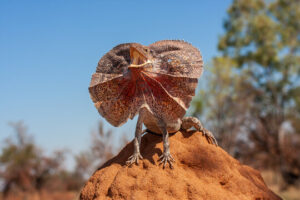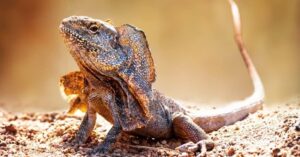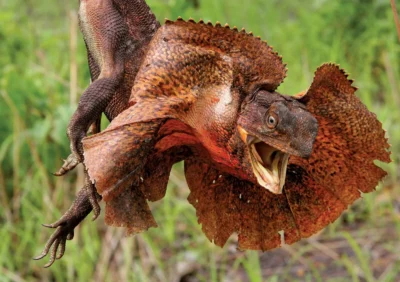What do frilled lizards eat? It’s a question that sparks curiosity about the dietary habits of these fascinating reptiles. Frilled lizards, scientifically known as Chlamydosaurus kingii, are renowned for their unique appearance, characterized by the impressive frill around their necks.
Frilled lizards are primarily insectivores, meaning they predominantly consume insects as their main source of food. Their diet typically includes a variety of insects such as crickets, grasshoppers, beetles, and other small invertebrates found within their natural habitat.
However, frilled lizards are also known to opportunistically feed on other small vertebrates when the opportunity arises. This may include small reptiles, amphibians, birds, and their eggs. Occasionally, they may even consume small mammals like rodents.
50 Types of Food Consumed by Frilled Lizards

Frilled lizards primarily feed on insects, and their diet can vary depending on availability and habitat. While it’s challenging to list 50 specific types of food consumed by frilled lizards, I can provide a diverse list of insects and other prey commonly consumed by them, along with their potential health benefits:
- Crickets: High in protein, calcium, and other essential nutrients, crickets are a staple food for frilled lizards, aiding in muscle development and overall growth.
- Mealworms: Rich in protein and fat, mealworms provide energy and help maintain healthy skin and coat.
- Dubia roaches: These roaches offer a good balance of protein and fat, supporting muscle strength and immune function.
- Superworms: High in protein and calcium, superworms promote bone health and aid in egg production for female frilled lizards.
- Silkworms: Silkworms are rich in protein and contain essential amino acids necessary for tissue repair and growth.
- Waxworms: While high in fat, waxworms provide a good source of energy for frilled lizards, especially during periods of increased activity or breeding.
- Butterworms: Butterworms contain beneficial fatty acids that support brain function and reproductive health.
- Phoenix worms (Black soldier fly larvae): These worms are packed with calcium, aiding in bone development and preventing metabolic bone diseases.
- Hornworms: High in moisture content, hornworms help prevent dehydration in frilled lizards, particularly in dry environments.
- Locusts: Locusts are rich in protein and low in fat, supporting muscle growth and overall health.
- Grasshoppers: Similar to locusts, grasshoppers are a good source of protein and essential nutrients for frilled lizards.
- Flies (including fruit flies and house flies): Flies are a readily available source of protein and can contribute to the overall nutritional balance of a frilled lizard’s diet.
- Beetles (including mealworm beetles): Beetles provide essential nutrients and fiber, aiding in digestion and gut health.
- Ants: Ants are rich in protein and antioxidants, supporting muscle development and immune function in frilled lizards.
- Termites: Termites offer a good balance of protein and carbohydrates, providing sustained energy for frilled lizards.
- Caterpillars: Caterpillars are rich in protein and essential fatty acids, supporting growth and overall health in frilled lizards.
- Earwigs: While not a primary food source, earwigs can provide supplemental nutrition for frilled lizards, containing protein and fat.
- Moths: Moths are rich in protein and vitamins, contributing to overall health and vitality in frilled lizards.
- Centipedes: Centipedes are a source of protein and minerals, aiding in muscle development and metabolic function.
- Spiders: Spiders provide protein and essential nutrients, supporting various physiological functions in frilled lizards.
- Woodlice (Isopods): Woodlice offer a source of protein and calcium, promoting bone health and muscle function in frilled lizards.
- Earthworms: Earthworms are rich in protein and minerals, supporting overall health and vitality in frilled lizards.
- Slugs: While low in nutritional value, slugs can serve as a supplemental food source for frilled lizards, providing hydration and some essential nutrients.
- Snails: Snails offer protein and calcium, aiding in muscle development and bone health in frilled lizards.
- Millipedes: Millipedes contain protein and fiber, supporting digestive health and overall well-being in frilled lizards.
- Shield bugs: Shield bugs provide protein and essential nutrients, contributing to muscle growth and immune function in frilled lizards.
- Aphids: Aphids are a source of protein and carbohydrates, offering energy and supporting growth in frilled lizards.
- Leafhoppers: Leafhoppers contain protein and vitamins, aiding in overall health and vitality in frilled lizards.
- Bees: Bees provide protein and essential fatty acids, supporting various physiological functions in frilled lizards.
- Wasps: Similar to bees, wasps offer protein and beneficial nutrients, contributing to overall health and well-being in frilled lizards.
- Dragonflies: Dragonflies are rich in protein and antioxidants, supporting muscle development and immune function in frilled lizards.
- Mayflies: Mayflies offer protein and essential fatty acids, aiding in growth and overall health in frilled lizards.
- Midges: Midges provide protein and carbohydrates, offering energy and supporting metabolic function in frilled lizards.
- Stoneflies: Stoneflies contain protein and minerals, contributing to muscle development and bone health in frilled lizards.
- Water striders: Water striders offer protein and essential fatty acids, supporting various physiological functions in frilled lizards.
- Dobsonflies: Dobsonflies are rich in protein and vitamins, aiding in growth and overall health in frilled lizards.
- Grubs: Grubs are a source of protein and fat, providing energy and supporting muscle development in frilled lizards.
- Beetle larvae: Beetle larvae offer protein and essential nutrients, contributing to overall health and vitality in frilled lizards.
- Stink bugs: Stink bugs provide protein and carbohydrates, offering energy and supporting metabolic function in frilled lizards.
- True bugs (e.g., cicadas, leaf bugs): True bugs contain protein and vitamins, aiding in growth and overall health in frilled lizards.
- Roly-polies (pill bugs): Roly-polies offer protein and minerals, contributing to muscle development and bone health in frilled lizards.
- Sowbugs: Sowbugs are a source of protein and fiber, supporting digestive health and overall well-being in frilled lizards.
- Fruit beetles: Fruit beetles provide protein and carbohydrates, offering energy and supporting metabolic function in frilled lizards.
- Flour beetles: Flour beetles are rich in protein and vitamins, aiding in growth and overall health in frilled lizards.
- Water beetles: Water beetles offer protein and essential fatty acids, supporting various physiological functions in frilled lizards.
- Aquatic insects (e.g., water striders, water boatmen): Aquatic insects provide protein and minerals, contributing to muscle development and bone health in frilled lizards.
- Booklice: Booklice are a source of protein and carbohydrates, offering energy and supporting metabolic function in frilled lizards.
- Leaf beetles: Leaf beetles contain protein and vitamins, aiding in growth and overall health in frilled lizards.
- Lacewings: Lacewings are rich in protein and antioxidants, supporting muscle development and immune function in frilled lizards.
- Stick insects: Stick insects offer protein and essential fatty acids, contributing to overall health and vitality in frilled lizards.
How frilled lizards adapt to seasonal changes in food availability?
Feeding Guidelines for Frilled Lizards Owners


